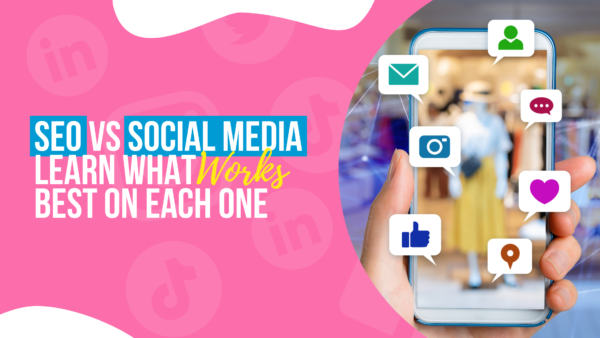Your cart is currently empty!

In this article, we’ll make a comparison of SEO vs Social Media. Web searches (SEO) and social media are key channels for all entrepreneurs. Both are sources of inbound traffic.
But PAY ATTENTION!
Social media and SEO are very different. They are opposites.
What we will do on this journey is to outline the 9 differences that exist between each of these two channels so that we can understand how to get the most out of them.
Are you ready? Get in, and I’ll take you on a tour of this little world…
While the person conducting a web search is focused on what they are doing (as no one goes to Google just to browse), the person on social media is simply passing the time while tapping on their cellphone screen.

That is to say, while one is searching for you, to the other, you simply appear. Small difference, isn’t it?
As we saw in the previous point, in web searches, there is an intention behind it, the user is searching for us for a reason. Therefore, we must try to solve their problem, answer their questions, and meet their expectations.
On the other hand, on social media, we must arouse their interest, quickly connect with their emotions, be something unexpected and immediately attractive.
Once again, two completely opposing objectives.
This is another huge difference that is associated with the ideas of the previous points.
In web searches, we have to use medium to long texts, and deep articles where research is carried out.
While on social media, it is the opposite. Since we need to capture attention in a few seconds, we need videos, images, memes, and audiovisual material.
This one is funny because it’s a play on words, but there’s no better way to express it.
In web searches, we don’t know anything about the person searching, but we can imagine what they are thinking about at that moment. Meanwhile, on social media, we have all the information about people (age, gender, location, etc.), but we have no idea what they think.
And speaking of thinking, did this point make you think?
By this, I mean who has more influence on the content you are creating.
When you write an article to publish on the web, add quotes from experts in the field. When you want to create something on social media, I recommend that you partner with influencers even if they have no idea what you are talking about.
In web searches, the demand is finite; the amount of traffic will never exceed the number of people searching for the topic in question. While on social media, there is always the possibility that it will go viral and reach an incalculable number of people.
In this point, we’ll refer to both the speed in the creation and growth of users, as well as the duration of the material.
In web searches, the generation of this material takes more time since it is longer and requires more preparation and research. The arrival of this material to users is slower because it also depends on their searches, but its duration is much longer. That said, a high-ranking URL can last for years.
The opposite occurs on social media, where content is fleeting. It is generated quickly, growth in views is fast, and it is forgotten just as quickly. This type of content requires much less research but requires continuous effort.
Those who arrive at your content through a web search are much more likely to buy or become leads. Why? Because they were already searching for you, and if you meet their expectations, the chance of conversion is high.
Meanwhile, on social media, the possibility of conversion is much lower, but these users are more likely to share and increase the visibility of the content.
Another point that works completely the opposite.
Visibility and traffic are easy to measure in web searches, but it is challenging to control user behavior metrics since they are not available. The opposite occurs on social media, where engagement metrics are easily visible, but total visibility is difficult to report.
Well, we have seen all the differences, and as we said at the beginning, they are completely and totally opposing.
So what do we do? What should we use? How? Where do we put our efforts to achieve the objectives we set ourselves?
Relax, breathe!
Here comes the solution: BOTH!
Let’s make these two channels work together to achieve maximum performance.

You may be wondering how to do this.
Use social media to consistently generate fleeting and creative content that captures attention, helps you become known, establishes collaborations, and invites those who are truly interested in what you do to delve deeper into your website.
Meanwhile, on your website, generate high-quality and useful content for users, while not forgetting to invite them to follow you on your social media.
And so, the circle of cooperation between these two communication channels is closed.
Since I follow this logic, I believe you have come to this article through a post I have made on my social media, but if not and you have arrived through a web search, I feel obliged to invite you to follow me on my social media where you will find daily content:
Sorry for the self-publicity but if I didn’t I would be failing this very article.
This trip is over, I hope you found it entertaining but above all useful. Surely you still have many doubts and that’s why I invite you to leave them in the comments and I’ll be trying to solve them.